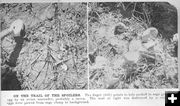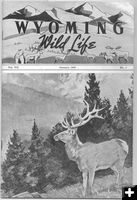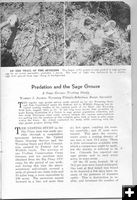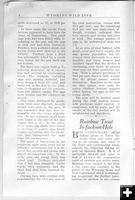

Broken Eggs
"On the trail of the Spoilers The finger (left) points to hole pecked in sage grouse egg by an avian marauder, probably a raven. The nest at right was destroyed by a coyote, eggs were pawed from sage clump in background." - caption from article.
|
|
Looking Back: Sage Grouse Studies (1942)
Predation and the Sage Grouse: A Sage Grouse Nesting Study
by Pinedale Online!
October 9, 2006
The Wyoming Game & Fish Department has been publishing their magazine, Wyoming Wildlife, monthly since 1935. The early editions offer interesting insight into wildlife issues faced by managers and biologists over the years in Wyoming. We found a copy of several Wyoming Wildlife issues from 1942. Below is a reprint of an article entitled “Predation and the Sage Grouse: Sage Grouse Nesting Study” written by Warren J. Allred, Wyoming Pittman-Robertson Range Specialist. Many of the same issues and concerns mentioned in this article studying sage grouse nesting in the Big Piney area more than 65 years ago are similar to what are being discussed today.
Introduction
The regular sage grouse survey work carried on by the Wyoming Game and Fish Department under the Federal Aid to Wildlife Program has included nesting studies in the various parts of the State (see Wyoming Wild Life, August, 1941, p.3). It has long been known that predation on nests during incubation is a factor in sage grouse population reductions, and this study illustrates what really serious inroads the various nest-predators are making into the numbers of this valuable game bird, at least in some areas within the State. Mr. Allred conducted the study while assisting with the sage grouse project, during 1940.
Article
The Nesting Study in the Big Piney area was made possible through a cooperative agreement between the United States Grazing Service and the Wyoming Game and Fish Commission, assisted by Federal Aid in Wildlife funds. The services of one Civilian Conservation Corps foreman and ten enrollees were obtained from the Big Piney CCC camp for the period of one week; and during this time the above-mentioned individuals covered a strip of ground one chain wide and 35 miles long, a tract equivalent to 280 acres. The surveyors moved forward in a line, not more than six feet apart, combing the country carefully; and 21 nests were located. This gave the country under study a nesting density of one nest to each 13.3 acres. There is a little information available with which a comparison might be made, but the density is believed to be low. Colorado has reported one sage grouse nest to each seven acres, in some areas.
Of the 21 nests located, 16 or 76.2 per cent were found destroyed. One nest at first intact was found to be deserted a few days later, because of the presence of domestic cattle. This is destruction in reality, and increases the number of nests destroyed to 17, or 80.9 per cent.
In three cases, the coyote, Canis latrans, appeared to have been the cause of destruction. Two adult sage hens had been killed while incubating on the nest, and the eggs in each case had been destroyed. Feathers were scattered about, and coyote tracks were observed in the vicinity. Feathers from a third hen presumably killed by a coyote were found, but the nest itself was not located.
The third nest believed destroyed by a coyote, was well covered by overhanging brush. The contents, including eggs and nesting material, had been dragged from the nest, and trails left in the dirt by the predator, in dragging out the contents, were still plainly visible. The eggs were broken and the contents removed.
Five nests destroyed by predaceous birds were observed. As only ravens were seen in the area, it was concluded that they were responsible for the avian depredation. In two instances, small holes were found in one side of the eggs. In the other three cases, egg shells were found in the tops of nearby sage brush clumps, indicating that the predators had transported the eggs there for consumption.
The agent of destruction in the remaining eight nests could not be definitely ascertained, but it is believed that coyotes and ravens both played an important role. In the study area one young chick was found dead. Evidence indicated that it had been trampled. Cattle tracks were numerous, and the chick had died from internal injuries.
Coyotes, then, were credited with responsibility for 14.3 per cent of the total destruction; ravens with 23.8 percent; and the remaining 61.9 percent was unascribed, although evidence indicated that both coyotes and ravens had been at work. The average number of eggs in the undestroyed nests was 7.3.
In an area of ideal habitat, with ample cover and water supply, the sage grouse population has decreased from thousands to a mere handful; and forest rangers and ranchers report that the decline is continuing, even under the present three-year-old State protective system. With a natural predation of 80.9 percent, there is little wonder that the grouse cannot sustain themselves. Ranchers in the area say they cannot even raise domestic chickens because magpies either destroy the eggs or kill the young chicks.
The area will be studies again with predators under control. A comparison will be made, and the results of the two studies will be enlightening and significant.
Source: Wyoming Wildlife, January, 1942, Vol. VII, No. 1, pgs. 3-4, Wyoming Game and Fish Department
|



